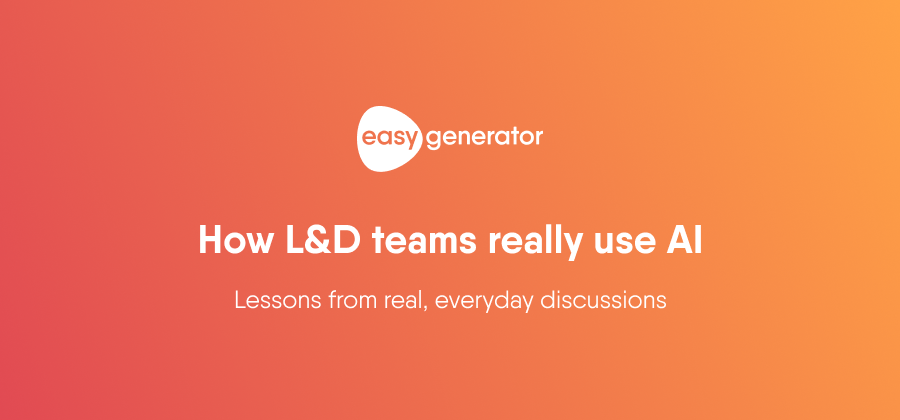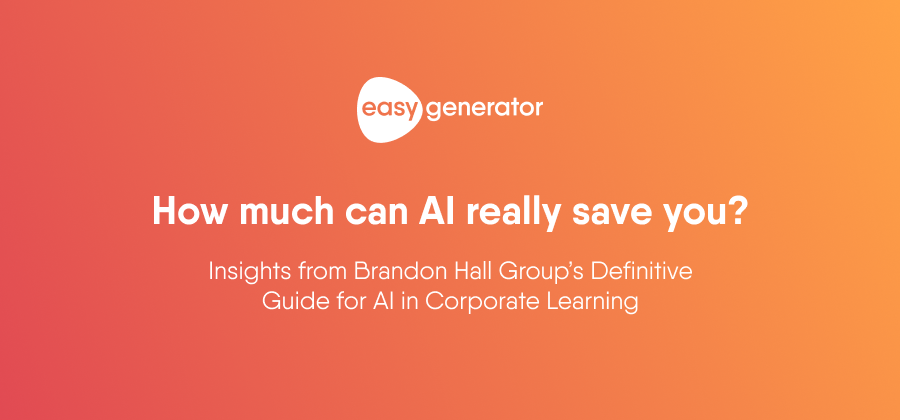Top 10 benefits of e-learning for your employees
Explore the top benefits of online learning and how it helps your employees grow, adapt, and stay engaged.

Conventional training methods can no longer keep up with our fast-changing, globalized society. A modern approach to learning should enable the freedom and flexibility to learn from anywhere in the world. In short, it’s time to embrace a culture of online learning for employees.
The rise of Employee-generated Learning
As the world of work changes, so does the way we learn. Traditional training methods can’t keep up with how fast things move in most companies. That’s why many organizations are turning to e-learning in companies as a more flexible, modern way to share knowledge. One of the most exciting shifts is a new approach called Employee-generated Learning, or EGL.
EGL is a way of learning where employees don’t just take courses, they help create them. Instead of relying only on L&D teams or outside trainers, companies can tap into the knowledge their own people already have. Subject matter experts (SMEs) can share their experience and insights directly with their coworkers by creating short, helpful learning content. This content can be as simple as a checklist or a short video, or even a full e-learning course.
There are many benefits to this approach. First, it’s faster. Because the people creating the content already know the topic, they don’t need long interviews or approvals. Second, it’s more relevant. Employees know exactly what others need to learn because they’re doing the work themselves. Third, it’s more scalable. Instead of one small team creating training for the whole company, anyone can contribute. This helps companies keep up with constant changes, like new tools, updated processes, or customer needs.
EGL also helps build a learning culture. When employees take the lead in sharing what they know, it creates a sense of ownership. People feel valued for their knowledge and more connected to their team. It also makes learning more social. Employees don’t just learn from a trainer, they learn from each other.
This doesn’t mean EGL replaces other forms of training. Instead, it works alongside them. For example, formal training is still important for topics like compliance or safety. But when it comes to fast-changing, job-specific knowledge, EGL is a powerful tool.
As companies move more training online, EGL fits in perfectly. It’s flexible, it’s fast, and it’s built for the way people work today. Before we dive into the top 10 benefits of online learning for employees, let’s keep in mind that the most effective learning isn’t just delivered from the top down. It comes from within the team, and that’s exactly what EGL makes possible.
10 Benefits of online learning for employees
1. E-learning aligns with a work-from-home culture
Now that many more employees are working remotely, e-learning is the best fit for learning in a work-from-home setup. As you continue to hire new employees remotely, creating an effective digital training program helps you keep up with remote onboarding needs.
And this culture of online learning is here to stay. Even as the pandemic fades away, more and more organizations will continue moving toward e-learning as their primary mode of corporate training.
2. Online training allows you to learn at your own pace
A traditional approach to education centers around strict class schedules, which can be limiting for people with other commitments, like work events or family matters. One of the advantages of e-learning is that it gives learners control over their schedule by providing access to course material anytime.
3. Employees take responsibility for their development
Besides time constraints, traditional education is also led by an instructor who decides what and how their students will learn. One of the pros of e-learning is that it changes this top-down approach. It shifts the learning responsibility from the instructor to the learners, supporting a variety of learning styles. By becoming less dependent on a structured learning program, learners can take ownership of their development.
4. Learners can beat the forgetting curve
Research shows that most people forget at least 75% of what they’ve learned in just a few hours. This is known as the forgetting curve. But one of the advantages of online learning is that it helps learners retain information.
By making your training content readily available, you empower employees to revisit it whenever they need it on the job. On the flip side, you can also easily share the most up-to-date content in real time, so employees always have the most relevant information on hand.
5. Creating e-learning content is cheaper and faster
Saving money is another major advantage of e-learning. That’s no surprise considering the savings an effective e-learning system can provide, especially for large organizations with thousands of employees around the world. Making your content available online also removes the need for expensive onsite facilities and printed materials.
Besides being cheaper than a traditional classroom setup, e-learning also helps organizations keep up with the fast pace of modern work. When employees learn at their own pace, your L&D team has more time to focus on higher-priority tasks instead of organizing face-to-face training.
When T-Mobile added an EGL approach to their e-learning strategy, they increased their learning output by five times using only 25% of their L&D resources. Because employees created the content, the L&D team could take on a more strategic, managerial role. That freed up time to focus on other tasks.
6. E-learning provides education on demand
Today’s employees are used to getting information instantly through platforms like Google, YouTube, Wikipedia, or a Learning Experience Platform (LXP). So it’s no surprise they might feel restricted by slower, traditional learning channels at work. That’s where online training offers clear benefits.
E-learning allows employees to decide for themselves what and when they learn. In return, you can meet them directly in their learning moments.
7. Easily track your learning progress
Another benefit of e-learning is that you can easily track progress and performance. Modern e-learning platforms provide detailed insights, not just test results, but also which resources employees use the most. This reflects one of the key merits of e-learning: helping L&D teams identify trends and make improvements when needed.
It’s a faster, more responsive way of teaching, and it saves time otherwise spent reviewing paper-based assignments.
8. E-learning is better for the planet
As the pandemic has shown, e-learning can lower a company’s carbon footprint. It helps reduce the need for printed materials, which saves paper and prevents the use of environmentally harmful inks.
But that’s not all. If employees no longer need to travel to in-person training sessions, your organization can significantly reduce carbon emissions. And by removing the need for large-scale training facilities like classrooms or auditoriums, you also save energy.
9. Online learning allows for immediate feedback
With e-learning, learners get feedback right away. For example, when someone answers a quiz question, they immediately see whether they were right or wrong. This helps them absorb the information while it’s still fresh, instead of waiting days or weeks for results.
And feedback goes both ways. You can include a rating system in your e-learning course, such as a net promoter score (NPS) survey, to see how learners feel about the content. This helps you decide where to improve. All courses created in Easygenerator include an NPS survey by default.
10. An online training model provides more concentration
Traditional learning environments come with lots of distractions. Even a teacher’s body language or tone of voice can pull focus away from the lesson. One advantage of online learning is that it reduces these distractions and helps learners stay focused on the content.
From helping your employees grow to lowering your company’s carbon footprint, there are many benefits of e-learning your organization can take advantage of.
Start enjoying the benefits of online learning today
Now that you know the benefits of e-learning, it’s time to learn how to create your own course. Try our accessible e-learning authoring tool to get started.
Easygenerator offers a user-friendly authoring experience with helpful support services, so anyone can get started, even without a background in instructional design. Try our free 14-day trial with unlimited access to all authoring features. No credit card required.
-
 14 day trial with access to all features. Start with variety of course templates.
14 day trial with access to all features. Start with variety of course templates. -
 Get unlimited design inspirations. Level up your courses.
Get unlimited design inspirations. Level up your courses. -
 Upload your PowerPoint presentations. Get instant courses created.
Upload your PowerPoint presentations. Get instant courses created.





